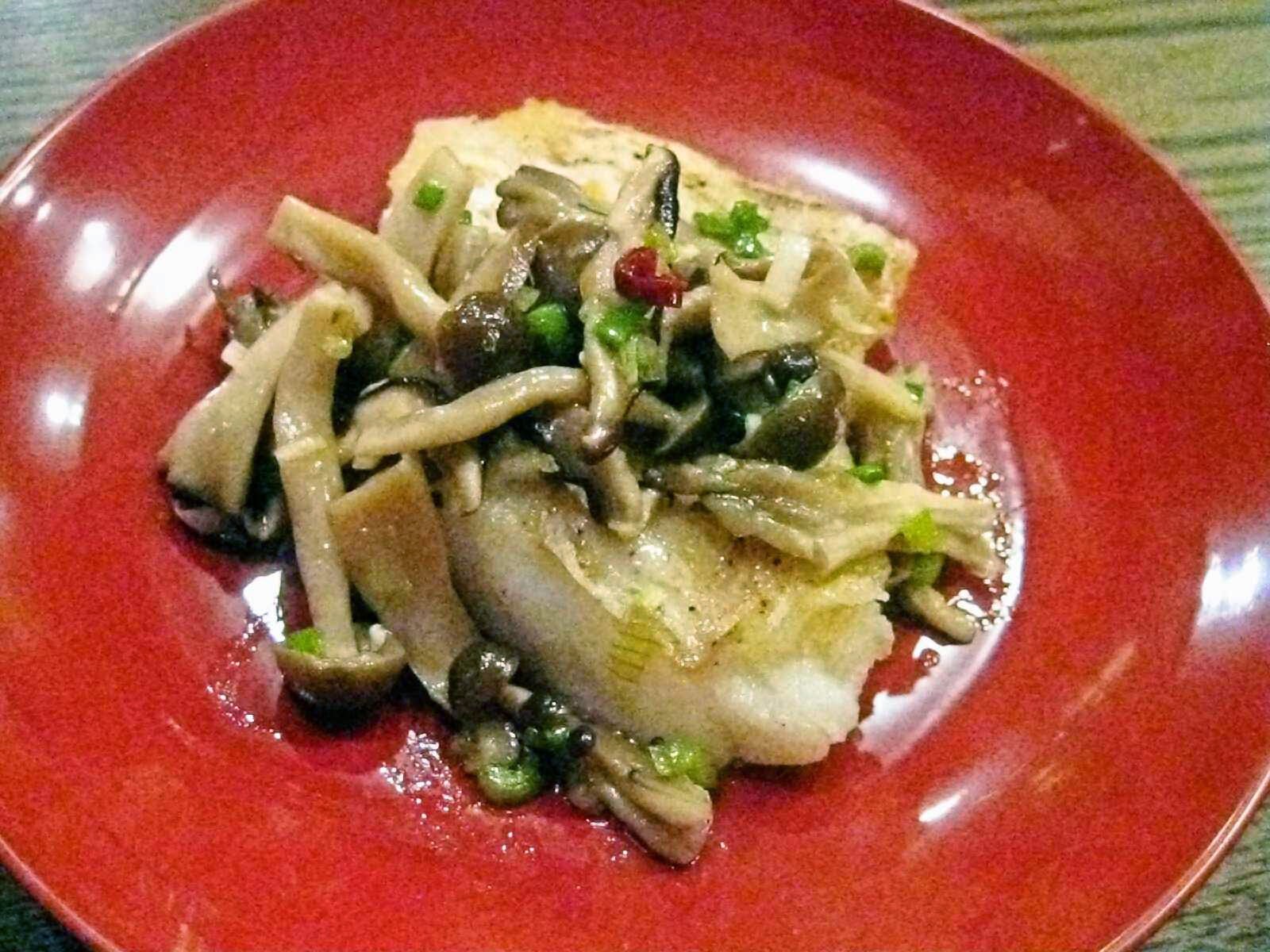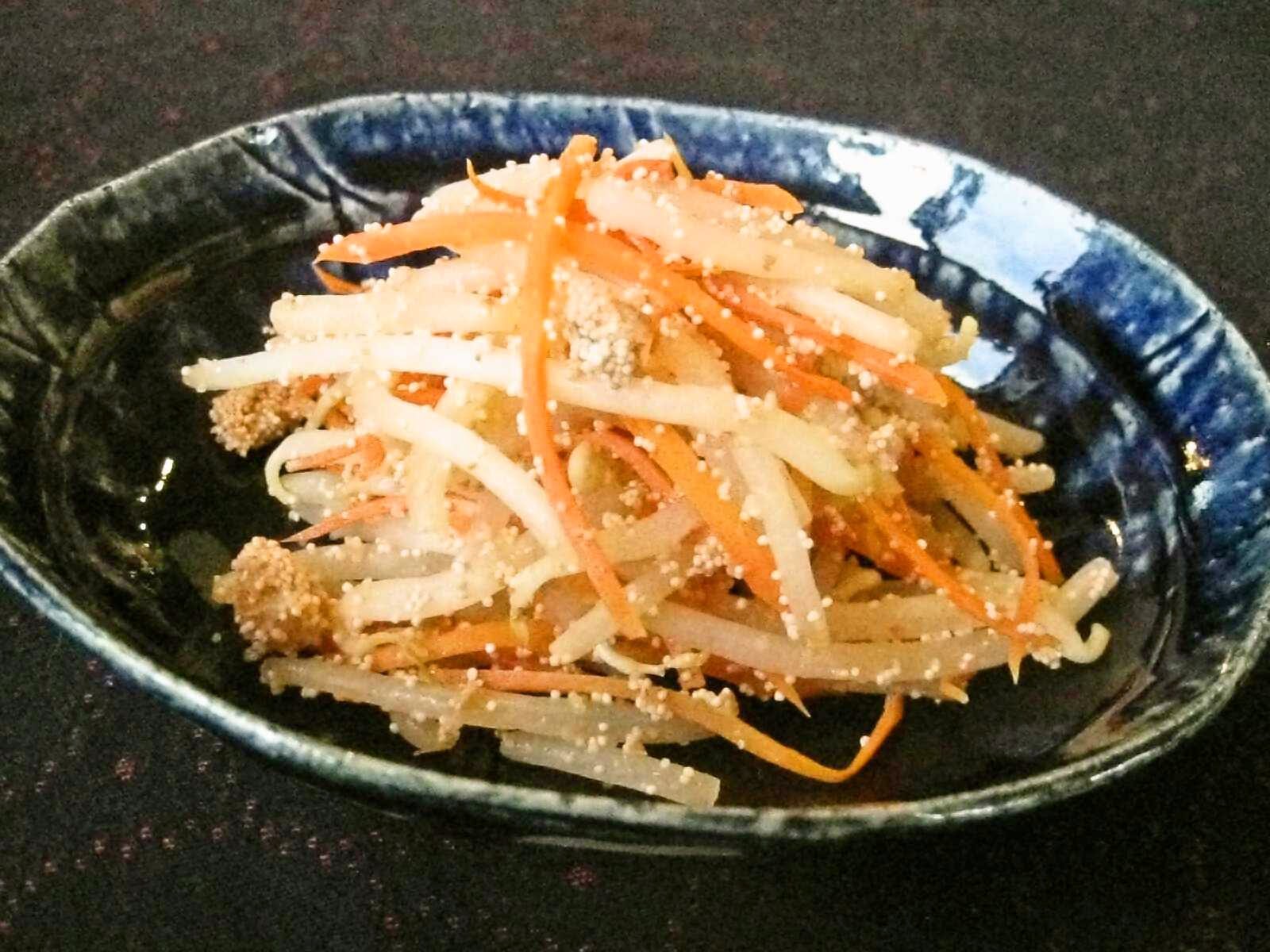All recipes are for 2 servings unless noted. Oil is canola oil and salt is kosher salt.
2014-03-31
2014-03-28
Sakana no sotee, karashi enoki soosu / sauteed fish with mustard enoki mushroom sauce
Enoki's fruity sourness goes well with mustard and white wine. The sauce is creamy, thanks to enoki, and has a clear soy sauce flavor, which also is a great match with mustard. For mustard lovers, this is a wonderful take on mushroom sauce.
1/2 of recipe:
154 calories; 18.6 g protein; 5.0 g fat; 6.7 g carbohydrate; 4.9 g net carbs; 275 mg sodium (with 50% reduced-sodium soy sauce; 389 mg with regular soy sauce); 59 mg cholesterol; 1.8 g fiber
1/2 of recipe:
154 calories; 18.6 g protein; 5.0 g fat; 6.7 g carbohydrate; 4.9 g net carbs; 275 mg sodium (with 50% reduced-sodium soy sauce; 389 mg with regular soy sauce); 59 mg cholesterol; 1.8 g fiber
Labels:
2 easy,
30 min,
cod,
enoki,
fish,
karashi,
Recipes - Japanese,
reduced sodium,
saute
2014-03-26
Tomato to asupara, tamago no itamemono, XO-jan soosu gake / fried tomato, asparagus and egg with XO sauce
This is one of the asparagus dishes that comes to mind when I see the vegetable start to appear at grocery stores in spring. An easy Chinese-style dish that pleases both your eye and palate.
1/2 of recipe:
122 calories; 5.7 g protein; 8.2 g fat; 7.9 g carbohydrate; 6.2 g net carbs; 153 mg sodium; 107 mg cholesterol; 1.7 g fiber
1/2 of recipe:
122 calories; 5.7 g protein; 8.2 g fat; 7.9 g carbohydrate; 6.2 g net carbs; 153 mg sodium; 107 mg cholesterol; 1.7 g fiber
Labels:
2 easy,
30 min,
asparagus,
blanch,
eggs,
microwave,
Recipes - Chinese,
reduced sodium,
stir-fry,
tomatoes,
vegetables,
XO-jan
2014-03-24
2014-03-21
Shiokoji kinoko / assorted steamed mushrooms with salted rice malt
A handy mushroom topping for a number of dishes, ranging from simple hiyayakko tofu to sautéed fish. This can also be added to vegetable or meat stir-fry as a quick taste and aroma booster. Use several different kinds of mushrooms for the best outcome.
1/6 of recipe (sauteed fish excluded):
27 calories; 1.1 g protein; 2.2 g fat; 2.0 g carbohydrate; 0.7 g net carbs; 37 mg sodium (with 50% reduced-sodium soy sauce; 44 mg with regular soy sauce); 0 mg cholesterol; 1.3 g fiber
1/6 of recipe (sauteed fish excluded):
27 calories; 1.1 g protein; 2.2 g fat; 2.0 g carbohydrate; 0.7 g net carbs; 37 mg sodium (with 50% reduced-sodium soy sauce; 44 mg with regular soy sauce); 0 mg cholesterol; 1.3 g fiber
Labels:
1 very easy,
10 min,
eringi,
green onions,
kinoko,
maitake,
make ahead,
microwave,
Recipes - Japanese,
reduced sodium,
shiitake,
shimeji,
shiokoji
2014-03-18
Sakana no oisutaasoosu-ni, howajao-iri / simmered fish in oyster sauce-flavored broth with Sichuan peppers
A light nitsuke simmered dish with a Chinese twist. Sichuan peppercorns impart a gentle, tingling sensation. As fish by itself is a bit lonesome, a couple of vegetables and mushrooms are added to complement each other.
1/2 of recipe:
114 calories; 17.1 g protein; 0.7 g fat; 10.5 g carbohydrate; 7.3 g net carbs; 196 mg sodium (with 50% reduced-sodium soy sauce; 235 mg with regular soy sauce); 46 mg cholesterol; 3.2 g fiber
1/2 of recipe:
114 calories; 17.1 g protein; 0.7 g fat; 10.5 g carbohydrate; 7.3 g net carbs; 196 mg sodium (with 50% reduced-sodium soy sauce; 235 mg with regular soy sauce); 46 mg cholesterol; 3.2 g fiber
Labels:
2 easy,
30 min,
chingensai,
daikon,
eringi,
fish,
maitake,
Recipes - Chinese,
Recipes - Japanese,
reduced sodium,
seafood,
simmer,
tara,
vegetables
2014-03-16
Fu wheat gluten cakes
 |
| Chikuwafu 竹輪麩: Common yakifu variation; chikuwa lit. means "bamboo ring" |
2014-03-14
Abekawamochi / rice cakes with sweetened roasted soybean flour
Also called kinakomochi, abekawamochi are heavenly soft rice cakes coated with a mixture of kinako soybean flour and sugar. Traditionally, mochi are baked then soaked in hot water to soften before coating with kinako. The abekawamochi I know from my childhood was always made with hot, freshly made rice cakes. Nowadays, individually packed square or round hard rice cakes are available for everyday use; here is a quick way to make a yummy and very filling snack.
1 abekawamochi (1/4 of recipe):
135 calories; 2.8 g protein; 0.9 g fat; 28.0 g carbohydrate; 27.3 g net carbs; 1 mg sodium; 0 mg cholesterol; 0.7 g fiber
1 abekawamochi (1/4 of recipe):
135 calories; 2.8 g protein; 0.9 g fat; 28.0 g carbohydrate; 27.3 g net carbs; 1 mg sodium; 0 mg cholesterol; 0.7 g fiber
Labels:
1 very easy,
10 min,
kinako,
low sodium,
microwave,
mochi,
Recipes - Japanese,
snack,
soybean flour
2014-03-12
Takenoko gohan / steamed rice with bamboo shoots
A reminder of spring. One of my favorite rice dishes when takenoko is in season.
1/3 of recipe:
210 calories; 4.9 g protein; 1.7 g fat; 40.9 g carbohydrate; 39.8 g net carbs; 95.3 mg sodium (with 50% reduced-sodium soy sauce; 146 mg with regular soy sauce); 0 mg cholesterol; 1.1 g fiber
1/2 of recipe:
315 calories; 7.4 g protein; 2.6 g fat; 61.4 g carbohydrate; 59.8 g net carbs; 143 mg sodium (with 50% reduced-sodium soy sauce; 219 mg with regular soy sauce); 0 mg cholesterol; 1.6 g fiber
1/3 of recipe:
210 calories; 4.9 g protein; 1.7 g fat; 40.9 g carbohydrate; 39.8 g net carbs; 95.3 mg sodium (with 50% reduced-sodium soy sauce; 146 mg with regular soy sauce); 0 mg cholesterol; 1.1 g fiber
1/2 of recipe:
315 calories; 7.4 g protein; 2.6 g fat; 61.4 g carbohydrate; 59.8 g net carbs; 143 mg sodium (with 50% reduced-sodium soy sauce; 219 mg with regular soy sauce); 0 mg cholesterol; 1.6 g fiber
Labels:
2 easy,
60 min,
bento,
party,
picnic,
Recipes - Japanese,
reduced sodium,
simmer,
takenoko,
usuage
2014-03-10
Shiitake mushroom
Lentinula edodes
2014-03-09
Konsai no sakekasu misoshiru / miso soup with root vegetables and sake lees
Hearty, satisfying and warming – and all you have to do is add sakekasu to your everyday miso soup. Aromatic and flavorful, sakekasu also lets you use even less miso than my recent low-sodium recipe for miso soup with yogurt.
1/2 of recipe:
50 calories; 2.3 g protein; 0.4 g fat; 9.0 g carbohydrate; 6.4 g net carbs; 189 mg sodium (with reduced-sodium miso; 234 mg with regular miso); 0 mg cholesterol; 2.6 g fiber
1/2 of recipe:
50 calories; 2.3 g protein; 0.4 g fat; 9.0 g carbohydrate; 6.4 g net carbs; 189 mg sodium (with reduced-sodium miso; 234 mg with regular miso); 0 mg cholesterol; 2.6 g fiber
Labels:
1 very easy,
30 min,
carrots,
daikon,
gobo,
green onions,
Recipes - Japanese,
reduced sodium,
sake lees,
sakekasu,
satoimo,
simmer,
soup
2014-03-08
Ebi to harusame no itamemono / stir-fried prawns and mung bean vermicelli
A tasty and filling stir fry for a hungry stomach. The flavor is light yet satisfying, making this a great companion for plain rice or drinks. The amount below is a bit too much for two, so there is plenty left over for a perfect bento item the next day.
1/3 of recipe:
193 calories; 11.1 g protein; 17.3 g fat; 18.7 g carbohydrate; 17.8 g net carbs; 280 mg sodium (with 50% reduced-sodium soy sauce; 331 mg with regular soy sauce); 131 mg cholesterol; 0.9 g fiber
1/3 of recipe:
193 calories; 11.1 g protein; 17.3 g fat; 18.7 g carbohydrate; 17.8 g net carbs; 280 mg sodium (with 50% reduced-sodium soy sauce; 331 mg with regular soy sauce); 131 mg cholesterol; 0.9 g fiber
Labels:
3 moderate,
30 min,
asparagus,
bento,
eggs,
harusame,
microwave,
mung bean vermicelli,
prawns,
Recipes - Chinese,
reduced sodium,
shrimp,
steam,
stir-fry
2014-03-06
Wakatakejiru, tara iri / clear soup with wakame seaweed and bamboo shoot, with grilled cod
Labels:
1 very easy,
30 min,
cod,
fish,
osumashi,
Recipes - Japanese,
reduced sodium,
seafood,
seaweed,
simmer,
soup,
takenoko,
tara,
wakame
2014-03-04
2014-03-03
Mentaiko no shionuki / desalinating spicy salted pollock roe
As with other salted food, mentaiko contains a high amount of sodium. Simply soaking it in water or even in salted water makes it bland. The secret is to add some red chili pepper in order to retain some spiciness while eliminating excessive sodium.
Subscribe to:
Posts (Atom)












